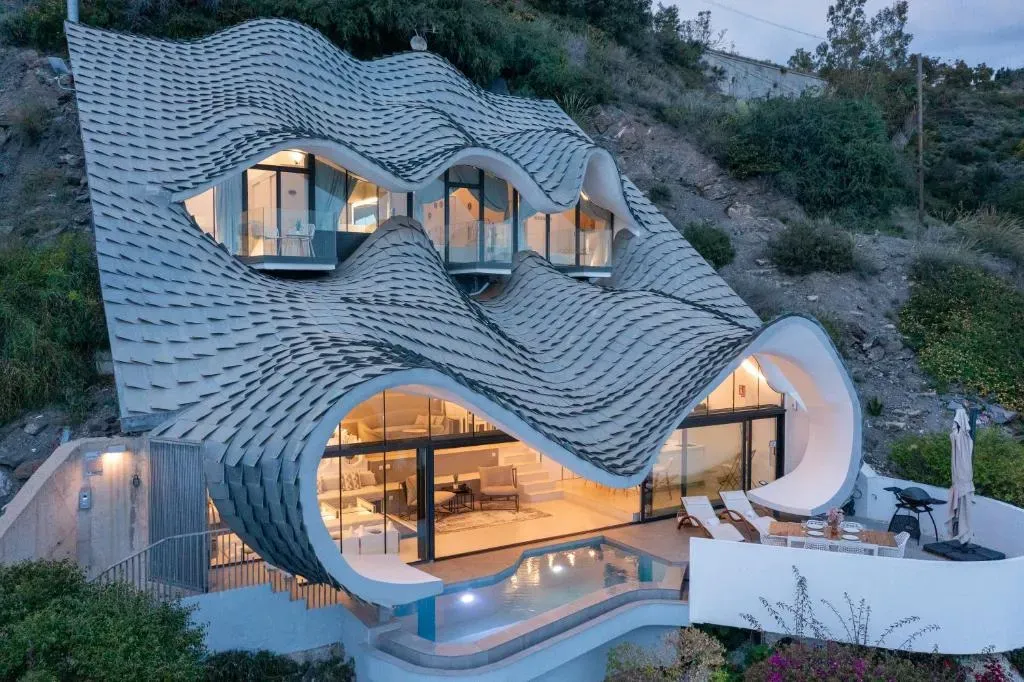Perched on a steep 42-degree incline overlooking the Mediterranean in Salobreña, Granada, Casa del Acantilado (House on the Cliff) stands as a testament to architectural ingenuity and contextual sensitivity. Completed in 2015 by Madrid-based GilBartolome Architects—led by Pablo Gil and Jaime Bartolomé—this private residence has garnered global attention for its daring design, innovative construction techniques, and a philosophy that champions craftsmanship over industrialization. A decade after its completion, the project remains a compelling case study in balancing technical complexity, environmental integration, and social responsibility in architecture.

Commissioned by a young Madrid couple, the house was born from an ambitious brief: to create a vacation home that maximized the site’s breathtaking sea views while maintaining privacy from neighboring properties. The plot’s extreme topography—a 42-degree slope—posed significant challenges, but also offered unique opportunities. GilBartolome responded with a design that embeds the 210-square-meter structure into the cliffside, leveraging the ground’s constant temperature of 19.5 to 20 degrees Celsius for natural climate control, a nod to Granada’s traditional cave dwellings. The house unfolds across two levels: a lower floor with a terraced living room that follows the slope, seamlessly connecting to a cantilevered terrace and infinity pool, and an upper floor housing three bedrooms, each with private balconies offering unobstructed Mediterranean vistas.
The defining feature of Casa del Acantilado is its roof—a double-curved, zinc-clad shell that evokes organic forms, often likened to a dragon’s skin or the undulating waves of the sea. Structurally, the roof is a technical achievement, developed in collaboration with engineer Manuel Rojas. It employs a novel system of deformable metal mesh formwork, which allowed for a highly efficient, handcrafted construction process. This method, detailed in ArchDaily, reduced costs significantly compared to conventional options like timber formwork or steel frameworks, dropping expenses to a fraction of industry standards. The zinc scales, supplied by Asturiana de Laminados (ElZinc) and fabricated on-site from raw coils, were meticulously placed over battens, further cutting costs compared to prefabricated roofing systems. This artisanal approach not only achieved the roof’s complex geometry but also imbued the project with a tactile, human quality that resonates with the local context.
From a technical perspective, the house’s integration into the cliffside is a masterclass in site-specific design. By burying the structure into the slope, GilBartolome minimized its visual impact on the landscape, ensuring that the building appears as an extension of the terrain rather than an imposition. The cantilevered terrace, with its infinity pool, projects dramatically over the cliff, creating a sense of suspension above the Mediterranean—a spatial experience that Gil and Bartolomé describe as an “explosive emotional experience,” inspired by their training at the Bartlett School of Architecture and their time working with avant-garde firms like Zaha Hadid Architects and Richard Rogers Partnership. The interior, captured in photographs by Jesús Granada, maximizes the connection to the sea through a retractable glass façade, blurring the boundaries between inside and out. The main living area, designed like an auditorium, can accommodate up to 70 people, reflecting the clients’ desire for a space that could host large gatherings while retaining an intimate, cave-like ambiance.
Beyond its technical innovations, Casa del Acantilado carries a deeper social narrative. Built during Spain’s severe post-2008 financial crisis, when unemployment in Granada soared, the project deliberately eschewed industrialized construction methods in favor of local craftsmanship. This decision, as GilBartolome notes, was a conscious effort to “restore dignity to the workforce,” employing local artisans—masons, carpenters, and metalworkers—whose skills were honed through the project’s challenges. The handcrafted zinc roof and bespoke furniture, fabricated by Jorge Alcalde of S’Decor, exemplify this ethos, offering a counterpoint to the construction industry’s trend toward automation. While this approach increased labor hours, it also created jobs and fostered a culture of quality and excellence, a principle the architects hoped would inspire broader change in the industry.
However, the project is not without critique. Its zoomorphic form—often described as resembling a dragon or a sea creature—has polarized opinions. Some, as seen in Reddit discussions from 2023, find its aesthetic “hideous” or impractical, questioning the long-term maintenance costs of the zinc roof and the safety protocols required for such a complex structure. Others, including the BBC, which featured the house in its 2016 documentary The World’s Most Extraordinary Homes: Coast (available on Netflix), celebrate its audacity, with hosts Piers Taylor and Caroline Quentin praising its integration into the landscape. The cost of the artisanal approach, while lower than industrialized alternatives, still required significant investment, raising questions about the scalability of such methods in a broader context where budgets are often constrained.
A decade after its completion, Casa del Acantilado—now available for rent on Airbnb as “Casa Acantilado”—continues to captivate. Its organic forms, sustainable design (requiring no air conditioning due to its subterranean cooling), and commitment to craftsmanship make it a landmark of contemporary architecture. Yet, it also prompts reflection on the role of architecture in times of crisis. While GilBartolome’s emphasis on local labor is admirable, the project’s exclusivity as a luxury vacation home underscores the tension between such bespoke designs and the pressing need for affordable housing in regions like Andalusia. As I reflect on this project in 2025, Casa del Acantilado remains a bold experiment—one that pushes technical and aesthetic boundaries but also invites us to consider who architecture ultimately serves.
